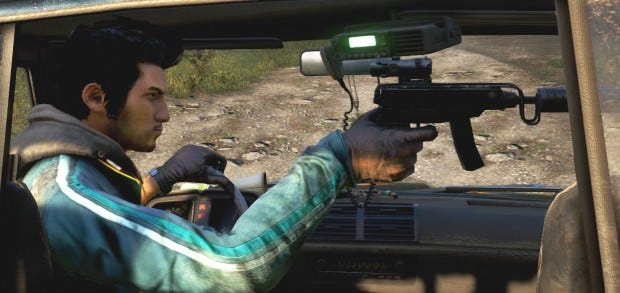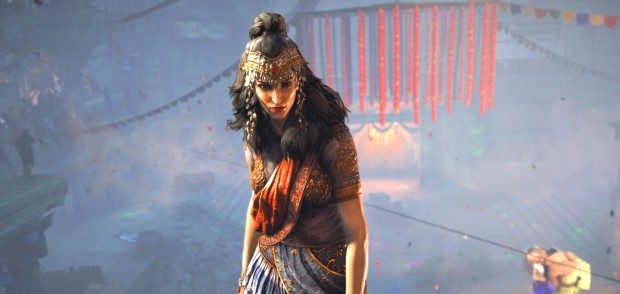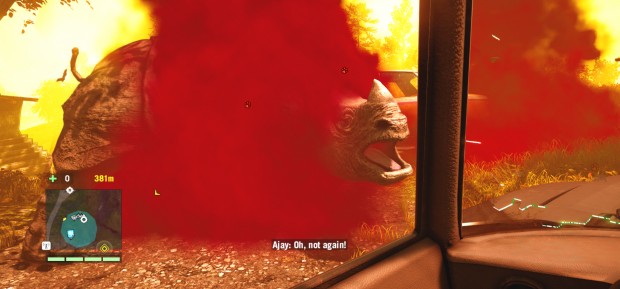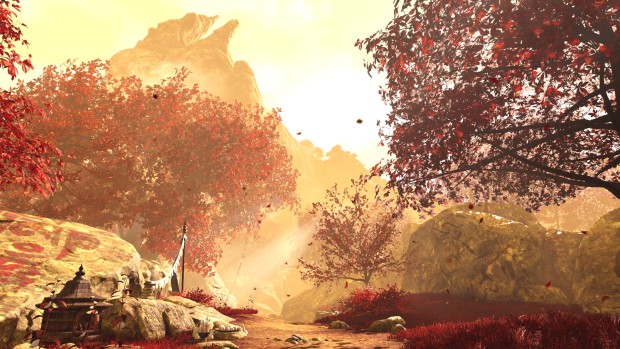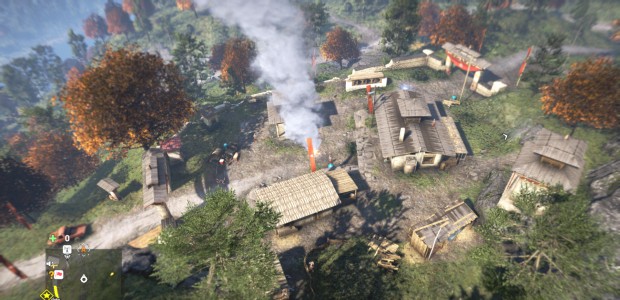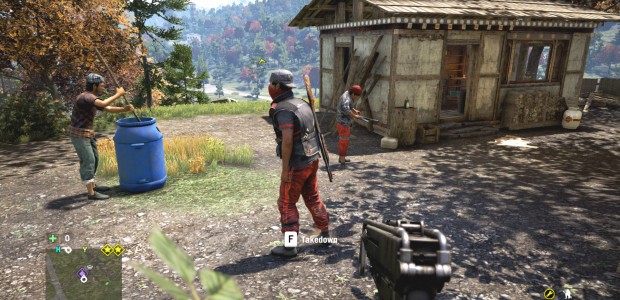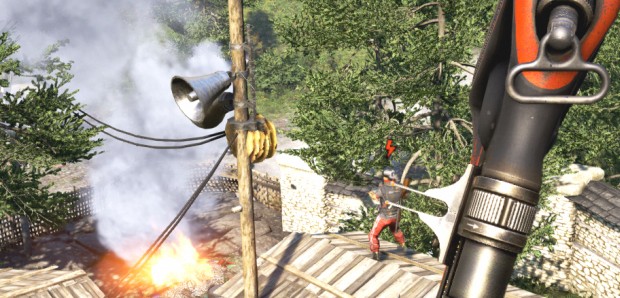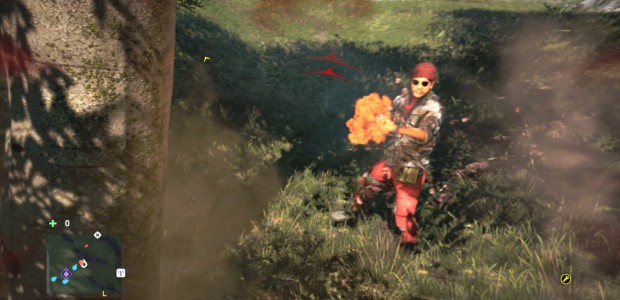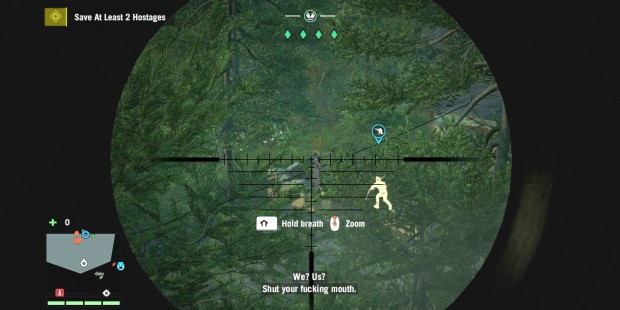Wot I Think: Far Cry 4
Far Cry Some More
Far Cry 4 is a funhouse mirror. I love pointing it in in different directions and seeing the way its design reflects the videogames around it. Angle it one way and the first thing you'll see in its reflection is the only-slightly distorted visage of its predecessor, as Far Cry 3's every idea turns formula: there's an exotic setting; an extravagant and verbose villain; crafting by way of animal hunting; a mixture of linear campaign and dynamic missions. This sequel could be considered a lavishly made standalone expansion pack and, if you enjoyed the previous game as I did, its slavish devotion to existing structures is no bad thing.
Angle it over here however, to the far corner, and you'll see in its curved surface a twisted take on everything the Elder Scrolls series has ever achieved, only with its Dungeons & Dragons influence shrunk bizarrely small. Far Cry 4 takes place in the fictional Himalayan country of Kyrat, and it's a beautiful open world, hemmed-in by snowy mountains, in which you venture through forests, stumble upon secret caves, become wrapped-up in sidequests at the risk of ever doing the awful primary missions, and earn points to be spent towards skill progression with every little action you perform.
Despite its beauty and the density of activities, Kyrat feels nothing at all like an actual world, and its mechanics are more rooted in Doom than in any RPG. There are no conversation trees, and characters with names and personalities exist almost solely in closed rooms and cutscenes separate from the broader world. You might have two-dozen methods of dealing with any given situation, and your unlocked abilities might offer you new syringes to craft or a greater reserve of hitpoints, but your main mode of interaction is always from behind the barrel of a gun.
The most interesting place to point Far Cry 4's twisted mirror however is towards that old RPS favourite - the immersive sim. Perhaps by accident Far Cry 4 is mainstream videogames' take on the same design principles that underpin a Looking Glass game.
That's best expressed by the game's forts, which were also the best part of the last game. As you drive, sail, fly or wingsuit across the terrain, smoke stacks rise up above the horizon, each one marking a camp containing half a dozen buildings, at least half a dozen guards, and an alarm or two. The challenge is to clear all the people away and to claim the camp for the rebel army you're fighting for, the Golden Path. You can approach these bubbles any way you want, and each of them is an unscripted puzzle.
Hurtling between destinations yesterday, I saw some smoke and decided on a whim to stop and take a look. There was a hill to the west on which I could see climbing points - prescribed areas where you can attach your grappling hook, one of the game's new toys. While the attach points are prescribed, the rope itself is physically simulated and you can use it to swing, to kick off from the wall, and to attach to points while falling, wingsuiting, or leaping between surfaces.
From atop the hill I get an overview of the situation. As in the previous game, your camera can be used to tag enemies on the map and confirm what type of threat they pose. I shuffle through the bushes, trying to cover every angle. I tag two snipers on different roofs, an armoured heavy carrying a flamethrower, a charger who'll sprint towards your location while lobbing molotovs, two normal soldiers, and a caged bear. Next I switch to locating the alarms - enemies will use them to call in reinforcements should you be spotted, introducing new enemies and vehicles into the mix.
Each of these targets introduces some hard rule to the situation which I'll have to bear in mind as I plan my attack. For example, I'll want to disable the alarms first, which I can do by getting close to them or by shooting them. If I shoot them, an enemy might hear the shot or the bullet, or a guard on patrol might later notice that it's broken. I can shoot a guard, but another will see the death or the body and start looking for me. If I can get close enough I can silently take down the guards with my knife and then hide the bodies, but being close puts me at greater risk of being spotted.
It's a case of creating and closing problems for yourself, and attempting to do so in a manner which makes life easier - or more interesting.
I've come to this particular party with a silenced sniper rifle and so I decide to keep my distance. I take out the alarm and, as predicted, a nearby heavy hears the bullet strike and moves to investigate. Heavies require a headshot to take down in a single hit and if I miss I'll only make things worse. I don't miss.
Normally I'd now move in closer and use my bow and knife to take down the rest, aiming to remain undetected while capturing the whole camp. I'm feeling jaunty though, so I take aim at the bear cage and shoot open its door with my rifle. The bear should be able to take down two of the nearest soldiers before being killed, allowing me to easily mop up the panicked few remaining.
The bear bursts from the cage. The soldiers turn and ready their aim at it… and the bear ignores them. Instead, it’s sprinting in my direction. I'm up a hill, in some bushes, and none of the guards know I'm here. But this bear does.
I missed someone when tagging the guards earlier: a Hunter. Hunters are a new guard type who only remain tagged for a few seconds when seen, and when alive, they affect animals in a way that causes them to never attack guards and always attack you. They're a neat new rule that changes the way you approach camps, not so much to make any old tactic useless, but enough that you need to always make sure there aren't any in your vicinity before you let loose or lure in an animal.
The bear is closing the distance between us fast. My sniper rifle is already useless at this range, and the bow and arrow is too weak to take it out before it reaches me. I switch to my sidearm, which isn't a pistol but a grenade launcher. Three shots and the bear falls just as it reaches me, but the downside is that everyone in the camp now knows I'm here. The upside? I'm already holding a grenade launcher. I finish the camp with a flurry of explosions.
I like to complete each camp stealthily, so being spotted in Far Cry normally prompted me to reload from a checkpoint. Here, I don't need to - run to the extinguished campfire at the center of any captured camp and you can re-populate and re-play a fort over and over again, attempting to either better your performance or to complete the objective in some new way.
This is where Far Cry excels. These camps are systemic puzzles in an open world full of toys. Maybe you want to climb a higher mountain and wingsuit directly into the middle of the camp. Maybe you want to approach from a river on a boat, or swim down to find an underwater cave that loops up and inside. Maybe you want to hover above the camp in one of the new gyrocopters, dropping explosives down on the helpless guards below. Maybe you prefer your weapon loadout to be a flamethrower, a harpoon gun, an AK-47. Maybe you want to charge in on the back of an elephant. Maybe you want to chain these things together in a single, choreographed action movie assault. Maybe you want to do any one of these things, but then a passing armored truck disrupts your plans, or wild boars decide to butt you in the butt while you're crouched in your hidey-hole.
Far Cry offers consistent rules and predictable systems, and then challenges you to maintain control in a world desperate to tip into chaos. Whether you succeed or fail, it's always fun and satisfying because you know the outcome is your fault, because you still have a lot of options, and because you can always run away or painlessly retry. These camps - and other similar activities like assassination, revenge and hostage missions - don't take place in a believable world, and are obscured by both the game's story and marketing, but together they form one of the most rewarding stealth games ever made.
Which is what I was thinking when I started playing the game in co-op. Far Cry 3 had an entirely separate co-op campaign which no one played, so Far Cry 4 instead lets two friends jump into the full open world together. All the singleplayer campaign missions - the awful ones I haven't talked about yet - are blocked off, leaving only the camps and other dynamic activities. Eg., the best bits. It's a right faff to get it working through uPlay: which of the two friends menus do I need to use? Why can't I receive party invites when I'm already in game? Why can't I invite specific friends to play with, instead of simply clicking a generic "Invite Friends" button?
But when you do stumble through the menus and get co-op functioning, it's sublime. I like piloting the gyrocopter while my friend stands on its frame, using his camera to tag enemies on the ground. I like even more that I can pilot the gyrocopter while my friend dangles from its undercarriage on a rope. I like perching atop my usual hill with a sniper rifle in hand, calling out enemy positions and clearing a path for him to go in low and quiet with his knife. I like coordinating takedowns, counting down our shots over voice comms.
I like that these are the pleasures of playing co-op in Splinter Cell or Rainbow Six: Vegas, except in that same open world toybox that makes the Far Cry 4 singleplayer so great.
Again, this gets lost among the cynicism over the Ubi-formula, the quick sequel, the trite cutscenes, but Far Cry 4 is a co-operative open world stealth game with consistent rules and predictable systems from which tense, chaotic, heroic and hilarious situations naturally arise. Let's not be blasé; these things are amazing, still too rare, and on their own make Far Cry 4 a delight.
Which is why I'm talking about the game without explaining much of what would normally be considered its most basic details: who you are, why you've come to this place, who the baddies are, and what the plot is. Those things don't matter. For the first time, there are hints that the game agrees they don't matter.
Blissfully, Far Cry 4's mirror never turns towards itself. Far Cry 3 was maligned for its colonialist storyline of a 'white saviour' being the hero for a native people, but also for its heavy-handed meta-commentary on the admittedly bizarre videogame power curve. While those efforts went some distance towards closing videogames' essential strangeness - by, for example, having your castaway friends stand witness to the changes in you - it also felt like the game was attempting to have its cake and eat it, using stupid or offensive tropes without the real wit or clarity to skewer them, upend them, rise above them.
Far Cry 4 doesn't so much aim to do better as to not do at all. The plot is paper thin. You are no longer a white saviour, as main character Ajay Ghale is native to Kyrat - albeit raised in America and returning as an adult for the first time with the aim of delivering his mother's ashes. Gone is Jason's self-entitled dialogue; gone are his douchebaggy friends; gone are at least some of the links between plot progression and skill progression. After a too-long, unskippable, unpausable cutscene that introduces the world, your character and flamboyant moustache-twirler Pagan Min, it's only a short hop and a skip to the big wide world.
From there, the game moves at double speed. Here is the obstacle: the site to which your mother requested her ashes be taken is behind enemy lines, as the country is in a decades-long civil war between Min's forces and the Golden Path, a rebel army founded by your long-dead father. Here is Ajay's immediately jumped-to solution: by joining the rebel army, murdering thousands, scaling radio towers, doing oddjobs and singlehandedly turning the tide of a war, you can make your dead Mum's wish come true. Ajay never states this as his intent. He never really states any particular long-term goal. He simply volunteers to do things on a whim, and no one around him flinches. Within 45 minutes of beginning the game I was doing a favour for an old lady, as a favour to a young lady, which involved crawling through a cave and firing arrows at explosive barrels in order to kill wolves which were disrupting a pig farm. It's fitting that Far Cry 2 director Clint Hocking is responsible for coining the phrase 'ludonarrative dissonance' to describe situations where game mechanics and story seem to pull in opposite directions, because Far Cry 4 is basically Ludonarrative Dissonance: The Game.
Importantly though, who cares. I am glad that there are games that strive for cohesion and offer richly detailed worlds, but it's unlikely that I'm ever going to care about the plot of a Far Cry game. What the series loses by jettisoning that impulse to justify, it makes up for by being inoffensively forgettable. I don't hate Ajay like I hated Jason, because he's just an empty shell. My slight curiosity over why he doesn't simply say, "Sod this, I'll scatter my ma in a nice park" is overwhelmed by my desire not to be bothered.
That's a desire made all the stronger by the activities in the campaign missions being by far the weakest parts of the game. These sometimes take part in siloed areas of the open world and sometimes in separate, high mountain locations and in either case they tend to shove you in a wide corridor and constrain your abilities in some way by triggering failstates if you're spotted, or removing some of your weapons. In doing so, these missions curtail some of the tactics you'll have learned and come to prefer in the rest of the game. That's frustrating in itself, but my real problem is that I don't think Far Cry's systems work well when confined.
If you're spotted under normal circumstances in Far Cry 4, you have a range of options to deal with the chaos. Number one is running away entirely, number two is relocating and approaching from a completely different position, number three is finding a vehicle that tips the balance of the fight. Those options aren't just nice to have, they're essential because enemies have been designed with the player's powerful toolset in mind. In the campaign meanwhile, you'll be railroaded into a narrow mountain pass. There'll be a high road and a low road, but no vehicles, no option to run away, no ability to wingsuit off the mountain. Death means restarting from a too-distant checkpoint and there is no mid-mission save, while being spotted means you're immediately exposed to every guard in the entire region, some of whom have mounted machineguns, some of whom are snipers, some of whom have rocket launchers.
The result is a game in which you stealth your way by six enemies, get spotted - sometimes because the enemies have been made artificially more powerful in ways not communicated - and then find yourself almost immediately blown up, knocked to the ground, and shot to death.
On other missions, like an airfield defense, your reward for stealthily completing a section is a subsequent section where you're forced to engage in all-out combat. Did you come kitted out in your favourite stealth gear? Then you better loot a body for a rattly machinegun fast, because now you need to play Call of Duty for a bit, dealing simultaneously with mortar fire, heavy-turret trucks, a dozen enemies or, worst of all, lame set-pieces where your wingsuit needs to be used to fly a fixed canyon route or a snowmobile must be used to jump a bridge. These moments feel pathetic and miserable next to an open world that habitually and authentically presents the same situations in ways you can control.
Do these alternately frustrating and boring missions harm Far Cry 4's greater strengths? Unfortunately, yes. Your geographic progression is linked to these story missions, and if you want to unlock the northern half of Kyrat - with its second batch of dynamic, emergent fun - then you need to play through more than two-thirds of the dreadful missions and dull plot. It's nice that skills, like all those knife takedowns, are now only tied to side missions, but it's time for the series to finally put the pretense of linearity away and embrace an open world where you can ignore the main plotline entirely. Make me an anonymous prisoner in a foreign and strange land; I won't complain that it's derivative.
In almost every other way, Far Cry 4 is almost too eager to make sure you're having fun. You'll find that gyrocopter within a couple of hours of play, and the game is perfectly happy for you to use it as I did, as an easy shortcut for reaching the top of radio towers, taking down camps and fortresses, and for speeding between every mission. I found the wingsuit - locked until after the halfway point in Far Cry 3 - on a bench about three hours in to Far Cry 4. It's up to you how much you want to use these powers, and I still prefer the feeling of off-road driving across the world than flying or fast travelling, but crafting at least is made almost worthless by the urgency with which it makes you powerful. While in Far Cry 3 I went hunting animals specifically in order to craft that bigger bag and be able to carry more things, here I never felt the need. I often run out of money, but I don't need money anymore except for ammo. I often run out of space for loot, but I don't need space for loot except to have items to sell - which I don't need to do because I don't need money, and so on.
Far Cry is a series still struggling with that balance, between offering you the freedom to do what you want while enforcing the limitations to make what you want meaningful. I think it's also only a game away from needing a gritty, Bond-style reboot back to its Far Cry 2 roots.
But the faults aren't what matters to me. Look beyond the campaign and Far Cry 4 is a razzle dazzle mainstream take on game design defined by being systemic, player-driven, always first-person, and with no fail states bar death. Looking Glass would be proud, and now that I've unlocked all its pleasures, the final thing reflected in Far Cry 4's funhouse mirror is my dumb, grinning face.
